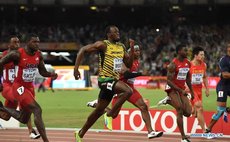Cashing in from sporting talent
No aspect of excellence in sports has ever gone unnoticed. Players revere their associates who are outstanding, and in a pursuit like cricket there is no end to a preoccupation with matters relating to highest scores, player averages and aggregates in batting and yardsticks to do with wicket taking. In football the spotlight falls glaringly upon goals scored, saves made etc, etc. It is not only the players themselves who are enthused with performance indices. For many the business of sport takes on the aura of a cult or religion. That's why there are the endless armies of spectators fanatical in the extreme towards support of players and teams they idolize. There are those who benefit from both direct and otherwise tangential involvement with sports.
Coaches and trainers are among the former, and so are managers and sports administrators! Early on it was held sacred that players should treat sport as a pastime and it was frowned upon that they should make money from it – even though it cost them much time and even money to support their ardent devotion to pursuing the love of their lives. In a sport like cricket there arose the class distinction typified by the label of "gentlemen" as against that of "players". The first were the amateurs and the latter were the professionals. Indeed, there was the pavilion entrance at the famed Lords Ground from which the gentlemen would go out to bat, and another from which the professionals would emerge. Gentlemen and pros were both part of the same teams but there was that difference in social status enshrined for all to see. The man who made his living from playing the game was considered an inferior breed to those who played but could afford to support themselves otherwise.
Inevitably a sport like tennis was fully encrusted with layers of elitism and rigid strictures of social castes. Players gloried in the monumental struggles aimed at winning a trophy that would signify as status for being the best player in the world – even though the organizers of the championship raked in mountains of cash, none of which went to the players who made it possible by their toil and sweat.
Of course, much as the veneer of compliance with prevailing custom was adhered to, players deep in their hearts felt the whole thing was blatantly unfair. Incidentally, the famed Suzanne Lenglen of France who won the women's singles title at Wimbledon five straight times from 1919 to 1923 and again in 1925, began providing an answer to all this. Her father acted as her manager. He knew his daughter was a stellar attraction with the crowds. Thus, he told the authorities she would – according to the social niceties of the day – receive nothing but he would have to be paid a tidy sum for bringing her to the tournaments!
In cricket itself there was no money in the game in Australia around the same era. How then would the man considered the greatest batsman ever, Sir Donald Bradman have supported himself in manner equating with the princely status accorded him – only in print? Countless Australian national companies' vyed to have his name on their business letterheads. This they had by enlisting him as company director at the ongoing fees of several hundred thousand dollars each per annum.
As earlier indicated, there are always those existing on the fringes of sport who remain ever eager to cash in on reputations of performers. There are the betting companies, known commonly as book makers. Most are legally established. However, as an outgrowth there are the downright parasites who seek to make easy money by inducing players to throw matches or to underperform to facilitate the gambling operations of those who have no genuine affection for sport. Unfortunately, there are players falling victim to the financial inducements of these gambling enterprises.
In the last few days during the Australian Tennis Open, the first of the years' four major tournaments, tennis authorities disclosed that investigations have been ongoing about some fifty or more professional players who have been approached for match fixing activities. Tennis, by the very mature of the sport, remains an enticing target for match fixers. Accordingly, it will take exhaustive efforts on the part of the well intentioned to enforce the much avowed zero tolerance needed to keep the sport clean.
Already, there has been an avalanche of seeds falling by the wayside in the first few days at Melbourne. This is cause for alarm and provides prime interest in seeing how behind the scenes probes into match fixing will reveal
One way of helping to counter the lure of match fixing would be to pay the players larger shares of prize money. In my humble opinion it is highly questionable to pay the emerging champions four million dollars (US) out of a pile which sees the organizers realizing several hundred million dollars in the annual takings from gates, television revenues etc. Twelve million dollars for the men's champion and similar amount for the women's champion would be equitable. Further, graded payouts ought to go all the way down the line to early losers. If there is such an arrangement there would be less likelihood of successful invasion in their ranks by unconscionable match fixers. The players would have already been assured of equitable guarantees of above the board remuneration.




